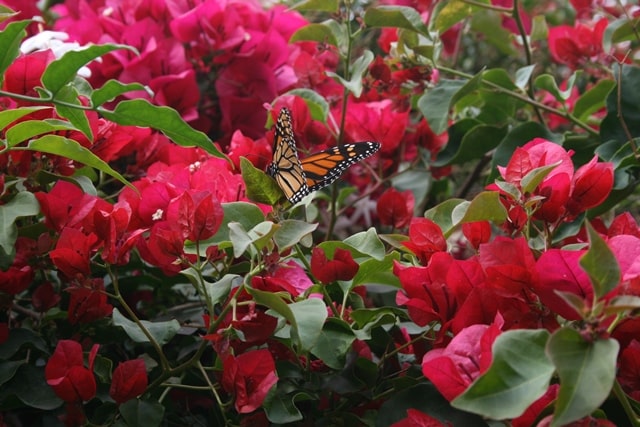It’s Pollinator Week (June 20-26). Time to celebrate the little creatures that ensure our crops produce fruits and veggies. A good way to do this is to preserve endangered pollinators like monarchs, whose populations have dipped over the last two decades.
With their intricately designed orange and black wings, these lovely creatures light up the backyard as they flit about. But don’t let their delicate features fool you. These are actually sturdy winged insects that migrate an astounding 1,200 to 2,500 miles. This migration occurs in autumn when they fly to Mexico to overwinter and again in spring when they return north to reproduce. They are able to find their way thanks to an internal GPS of sorts that points them in the right direction.
You can help preserve monarchs and ensure that we continue to enjoy them in nature and our gardens by keeping a few tips in mind.
Plant Milkweed (Asclepias species) for Monarchs
Monarch adults only lay their eggs on milkweed (Asclepias), because their resulting caterpillars will only eat milkweed. Milkweed is easy to grow in the garden and comes in orange, pink, purple, yellow and white. Many species reseed readily in the garden, but this is a good thing, because the more milkweed, the more monarchs gracing your garden.
Besides being tasty to caterpillars, milkweed helps the insects ward off predators. It turns out that milkweeds contain glycoside toxins. These are harmless to the monarchs, but make the insects poisonous to predators in the caterpillar and adult butterfly stage.
 Monarch on Cone Flower (Joe Kucharski, freeimages.com)
Monarch on Cone Flower (Joe Kucharski, freeimages.com)
Add Nectar Plants to the Mix
Adult monarch butterflies like to dine on a wide variety of nectar flowering plants. Add a wide range of blooming plants to your garden, including butterfly bush (Buddleia), Echinacea, Mexican flame vine, orange cosmos (Cosmos sulphureus) Mexican sunflower (Tithonia), sunflower, azalea, bee balm, echium, liatris, Mexican bush sage (Salvia leucantha) Verbena bonariensis, some pentas, allium, goldenrod, rudbeckia, lantana and zinnia.
Protect Monarch Caterpillars
Familiarize yourself with the large caterpillars featuring black, yellow and white bands and black tentacles on their front and hind ends. These will undergo metamorphosis and become monarchs. This process starts when the adult monarch lays eggs on the milkweed, and the eggs hatch in about four days. The caterpillars then grow over a two-week period while feeding on the milkweed foliage. They then form a chrysalis, which is green with yellow spots. Two weeks later the adult monarch emerges from the chrysalis.

Monarch caterpillar (Rachel Kirk/freeimages.com)
Prevent killing monarch caterpillars and other beneficial insects in your garden by avoiding the use of pesticides. Instead of spraying, handpick harmful pests like Japanese beetles and tomato hornworms, and spray aphids with a steady stream of water. If you want monarchs in your garden, you’ll need to tolerate feeding damage on your milkweed foliage. Know that the more bites you see, the more butterflies you’ll be able to enjoy.
Congratulate Yourself
When you see monarchs flying around your garden, pat yourself on the back. Not only do you get a private show of these magnificent winged beauties, you can congratulate yourself for doing your part to protect our precious pollinators.
Julie Bawden-Davis is a garden writer and master gardener, who since 1985 has written for publications such as Organic Gardening, Wildflower, Better Homes and Gardens and The Los Angeles Times. She is the author of seven books, including Reader’s Digest Flower Gardening, Fairy Gardening, The Strawberry Story, and Indoor Gardening the Organic Way, and is the founder of HealthyHouseplants.com.

